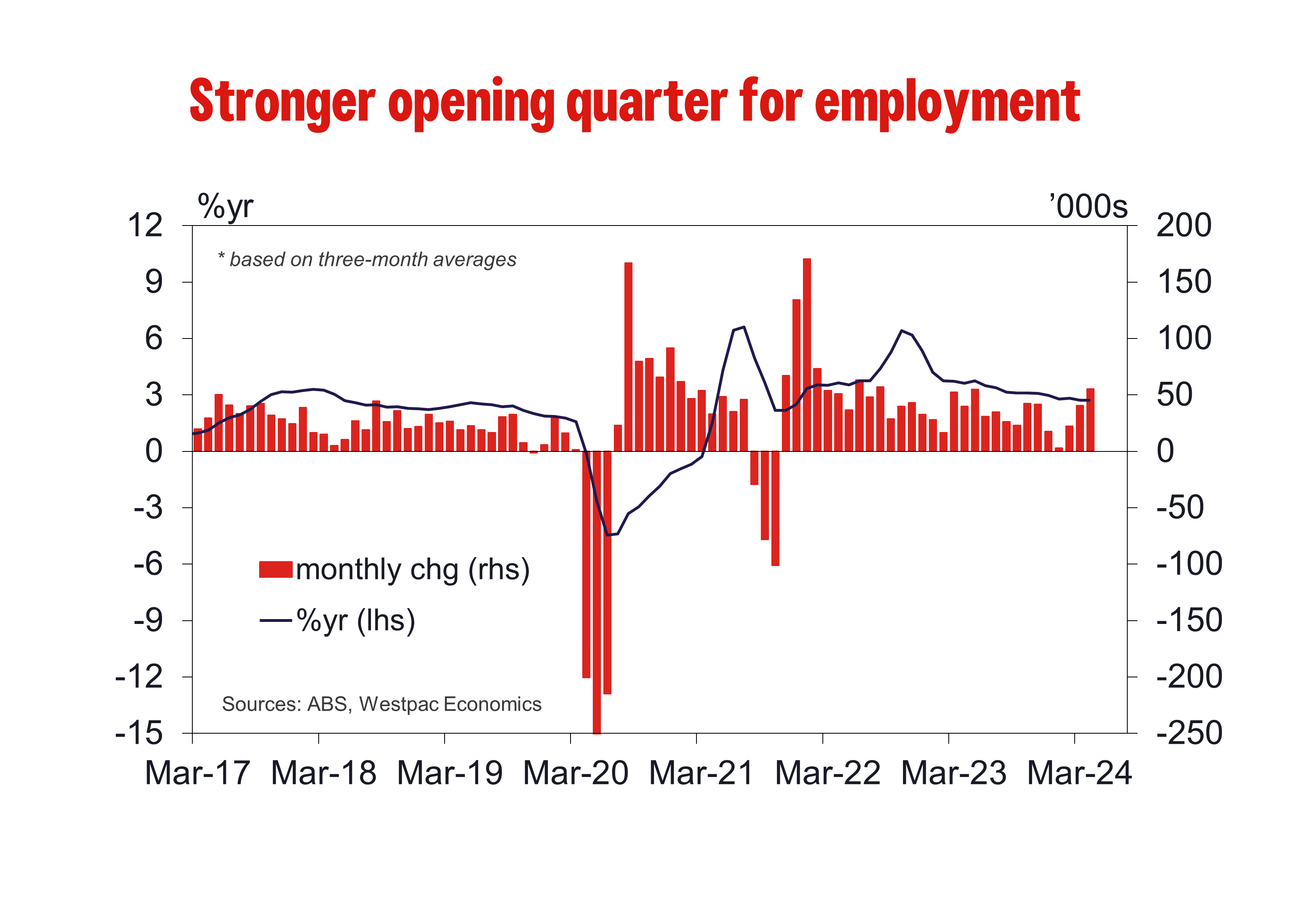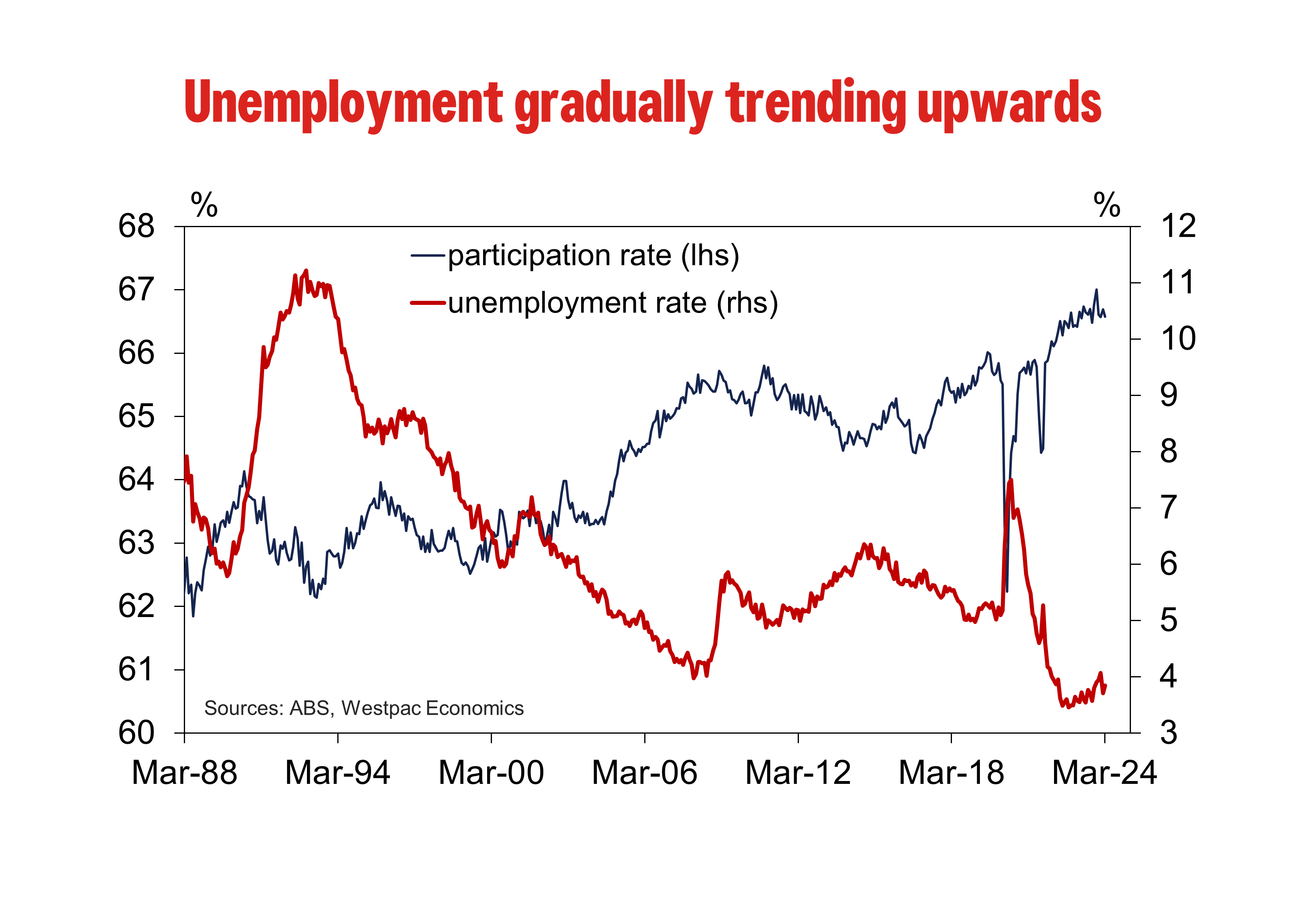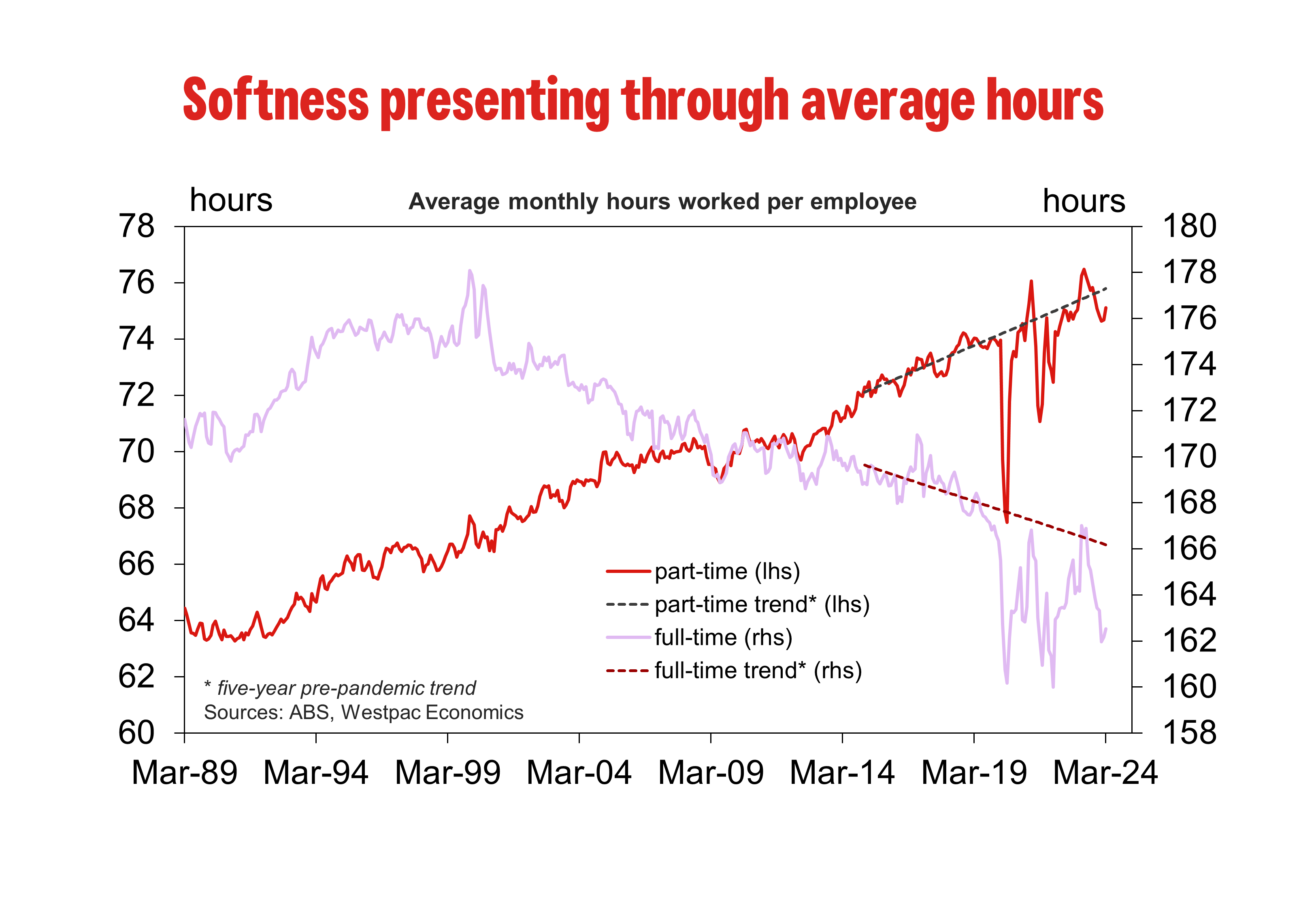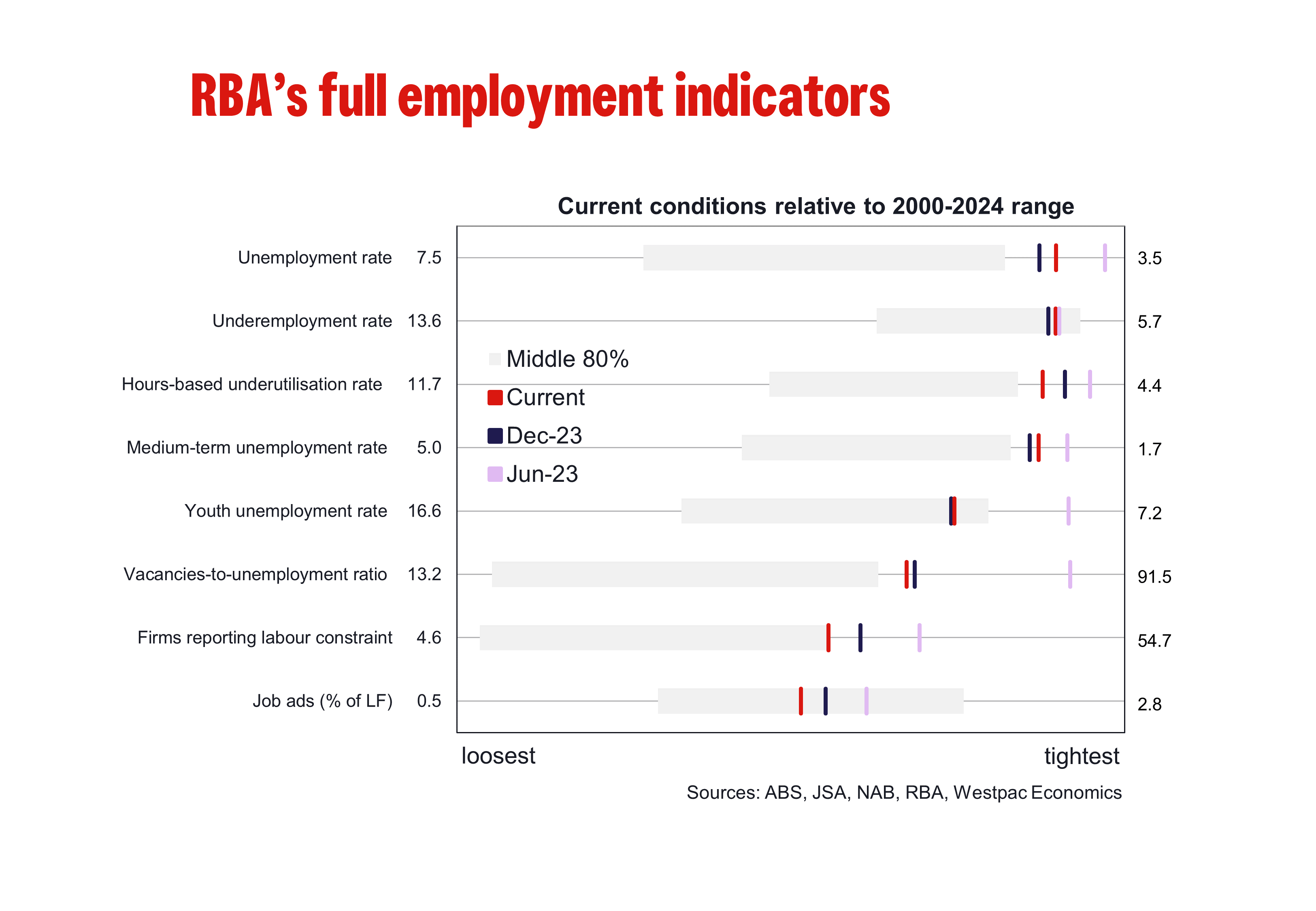March Labour Force: rounding out a volatile quarter
Employment: –6.6k (from +117.6k). Unemployment Rate: 3.8% (from 3.7%). Participation Rate: 66.6% (from 66.7%).

The March Labour Force Survey (LFS) delivered mixed of results following a particularly volatile start to the year for the labour market.
After an incredibly strong showing in February, where employment managed to lift +117.6k (revised up slightly from +116.5k), employment declined only slightly in March, down –6.6k. That decline was centred on part-time employment (–34.5k), which effectively took back last month’s gain, while full-time employment continued to rise into the final month of the quarter (+27.9k). The headline result was weaker than the market median (+10k) but was not as weak as we had anticipated (–40k).
While March’s employment print does mark somewhat of a ‘retracement’ from a particularly strong February, it rounds out a more resilient performance for employment growth over the quarter as a whole. Indeed, Q1 2024 saw a cumulative lift of +122.3k in employment, the largest quarterly rise since Q1 2023 (+157k). Results on a quarter-average basis are a little more tempered but were still firmer than what was initially anticipated by most analysts, up 0.5% (2.7%yr) in Q1 2024. That remains consistent with the broader context of a trend slowdown however, easing from 3.0%yr in Q4 2023 and 3.1%yr in Q3 2023.
While labour demand has certainly cooled over the past year, it remains in generally robust health to the extent that employment growth remained moderately positive. That is consistent with results from other data on job vacancies, which continues to highlight a large ‘overhang’ of available jobs relative to pre-pandemic levels. However, other results from the LFS – particularly in relation to hours worked (below) – provides some nuances.
With growth in the working age population (2.9%) still outstripping employment growth, the employment-to-population moderated from 64.2% in February to 64.0% in March. While we anticipate growth across both the working age population and employment to moderate over the remainder of the year, the former will likely continue to outstrip the latter, which will see the employment-to-population ratio fall over 2024 after having moved broadly sideways near historic highs over much of 2023.

Unemployment Rate
Results around labour force participation met our expectations, with the participation rate moving lower from 66.7% in February to 66.6% March. That implied a modest lift in the size of the labour force, up +14.0k. Given employment declined in the month (–6.6k), there was a rise in the number of unemployed persons (+20.6k), which saw the unemployment rate move slightly higher, from 3.7% In February to 3.8% March.
It should be noted that given we had expected a larger decline in employment, that result for the unemployment rate in March was better than we anticipated. At 3.9% on a quarter-average basis, the unemployment rate is virtually unchanged from Q4 2023, but remains higher than what it was a year ago (3.6%). Should these broad trends persist near-term, it would present downside risk to our year-end forecast for the unemployment rate at 4.5%.

Hours Worked
The number of hours worked increased 0.9% in March, to be 1.7% higher in annual terms. The increase in hours worked was broad based with all states recoding gains: WA (2.1%), Tasmania (1.5%), Queensland (1.1%), Victoria (0.7%), NSW (0.6%) and SA (0.4%).
However, growth in hours worked over the March quarter was flat (0.0%). This continues the recent run of weak growth in hours worked, which declined 0.5% over the December quarter 2023 and fell by 0.9% in the September quarter 2023. The degree of weakness has progressively lessened between Q2 2023 and Q1 2024.
The pick-up in employment growth, coupled with weak growth in hours worked, means on average people are working less hours. We have seen falls in the average number of hours worked by both full time and part time employees.
We have also seen a significant fall in the share of part time workers who are able to pick up extra hours and move to full time status (those working 35hrs/wk or more). This has seen the share of full-time employment fall from around 70.1% a year ago to 69.1% today, and trending toward the pre pandemic average of around 68.5%. This suggests that labour demand in terms of average hours has slowed, while the growth in employment suggests that demand is resilient. One possible explanation for this apparent disconnect could be that there is a mismatch between supply and demand and the labour market is rebalancing towards areas where workers are likely to work a smaller number of hours. If we were to take the cue solely from employment, it suggests that labour market conditions could remain fairly resilient. But, if we were to take the cue from average hours, it suggests that there remains some downside risk to labour demand over the period ahead.

Potential Labour Supply
The bounce back in international students and immigrants returning to Australia when borders reopened was larger than anyone expected. As a result, the working age population grew at a record pace for most of last year. This now looks to have peaked, in the month of September 2023 when looking at the annual growth rate. Despite this, the change in the working age population continues to outpace employment. We expect this will continue to occur going forward. This is consistent with a loosening in labour market conditions – with the unemployment rate drifting higher and the employment to population ratio moving lower.
Other Labour Market Measures
Consistent with the bounce back in the number of hours worked, some other labour market indicators also improved over March.
The underemployment rate, which measures the share of employed workers who are willing and able to work more hours, ticked down to 6.5% in March. Over 2023 the underemployment rate has drifted higher in trends terms, coinciding with the slowdown in economic activity.
The underutilisation rate, which combines the unemployment and underemployment rates, remained steady at 10.3%. Consistent with the underemployment rate, the underutilisation rate has drifted higher in trends terms, from 9.5% in late 2022 to 10.3% in March 2024 (trend terms).
The youth unemployment rate, which measures the share of unemployed workers between the ages of 15 and 24, increased to 9.6 % from 9.1% last month. This was the biggest monthly increase since November 2023. The unemployment rate for this segment has trended higher since late 2022, with the participation rate also tending lower over this period. Being a highly sensitive group to changes in labour demand, this provides another signal that softness in labour demand is emerging.

Outlook
The March LFS incorporated somewhat of a ‘pay-back’ from an incredibly strong February, but on balance, it provided a slightly better read on the underlying state of labour market conditions over the opening quarter. That is predominately in relation to the results around employment, which was stronger-than-expected, and the unemployment rate, which remains little-changed on a quarter-average basis since December 2023. However, the survey did present some nuances around average hours worked, confirming that a trend easing in labour market conditions remains present.
The extent to which labour demand will continue to cool over the near-term, however, critically depends on the interplay between headcount and hours. We continue to expect most of the softening in labour demand to present via an easing in average hours worked, with prospects of material economy-wide declines in employment seeming less likely at this stage.
Ryan Wells, Economist, ph (61–2) 9178 2063
Pat Bustamante, Senior Economist, ph (61) 468 571 786
Browse topics
Disclaimer
©2024 Westpac Banking Corporation ABN 33 007 457 141 (including where acting under any of its Westpac, St George, Bank of Melbourne or BankSA brands, collectively, “Westpac”). References to the “Westpac Group” are to Westpac and its subsidiaries and includes the directors, employees and representatives of Westpac and its subsidiaries.
Things you should know
We respect your privacy: You can view our privacy statement at Westpac.com.au. Each time someone visits our site, data is captured so that we can accurately evaluate the quality of our content and make improvements for you. We may at times use technology to capture data about you to help us to better understand you and your needs, including potentially for the purposes of assessing your individual reading habits and interests to allow us to provide suggestions regarding other reading material which may be suitable for you.
This information, unless specifically indicated otherwise, is under copyright of the Westpac Group. None of the material, nor its contents, nor any copy of it, may be altered in any way, transmitted to, copied of distributed to any other party without the prior written permission of the Westpac Group.
Disclaimer
This information has been prepared by the Westpac and is intended for information purposes only. It is not intended to reflect any recommendation or financial advice and investment decisions should not be based on it. This information does not constitute an offer, a solicitation of an offer, or an inducement to subscribe for, purchase or sell any financial instrument or to enter into a legally binding contract. To the extent that this information contains any general advice, it has been prepared without taking into account your objectives, financial situation or needs and before acting on it you should consider the appropriateness of the advice. Certain types of transactions, including those involving futures, options and high yield securities give rise to substantial risk and are not suitable for all investors. We recommend that you seek your own independent legal or financial advice before proceeding with any investment decision. This information may contain material provided by third parties. While such material is published with the necessary permission none of Westpac or its related entities accepts any responsibility for the accuracy or completeness of any such material. Although we have made every effort to ensure this information is free from error, none of Westpac or its related entities warrants the accuracy, adequacy or completeness of this information, or otherwise endorses it in any way. Except where contrary to law, Westpac Group intend by this notice to exclude liability for this information. This information is subject to change without notice and none of Westpac or its related entities is under any obligation to update this information or correct any inaccuracy which may become apparent at a later date. This information may contain or incorporate by reference forward-looking statements. The words “believe”, “anticipate”, “expect”, “intend”, “plan”, “predict”, “continue”, “assume”, “positioned”, “may”, “will”, “should”, “shall”, “risk” and other similar expressions that are predictions of or indicate future events and future trends identify forward-looking statements. These forward-looking statements include all matters that are not historical facts. Past performance is not a reliable indicator of future performance, nor are forecasts of future performance. Whilst every effort has been taken to ensure that the assumptions on which any forecasts are based are reasonable, the forecasts may be affected by incorrect assumptions or by known or unknown risks and uncertainties. The ultimate outcomes may differ substantially from any forecasts.
Conflicts of Interest: In the normal course of offering banking products and services to its clients, the Westpac Group may act in several capacities (including issuer, market maker, underwriter, distributor, swap counterparty and calculation agent) simultaneously with respect to a financial instrument, giving rise to potential conflicts of interest which may impact the performance of a financial instrument. The Westpac Group may at any time transact or hold a position (including hedging and trading positions) for its own account or the account of a client in any financial instrument which may impact the performance of that financial instrument.
Author(s) disclaimer and declaration: The author(s) confirms that no part of his/her compensation was, is, or will be, directly or indirectly, related to any views or (if applicable) recommendations expressed in this material. The author(s) also confirms that this material accurately reflects his/her personal views about the financial products, companies or issuers (if applicable) and is based on sources reasonably believed to be reliable and accurate.
Further important information regarding sustainability-related content: This material may contain statements relating to environmental, social and governance (ESG) topics. These are subject to known and unknown risks, and there are significant uncertainties, limitations, risks and assumptions in the metrics, modelling, data, scenarios, reporting and analysis on which the statements rely. In particular, these areas are rapidly evolving and maturing, and there are variations in approaches and common standards and practice, as well as uncertainty around future related policy and legislation. Some material may include information derived from publicly available sources that have not been independently verified. No representation or warranty is made as to the accuracy, completeness or reliability of the information. There is a risk that the analysis, estimates, judgements, assumptions, views, models, scenarios or projections used may turn out to be incorrect. These risks may cause actual outcomes to differ materially from those expressed or implied. The ESG-related statements in this material do not constitute advice, nor are they guarantees or predictions of future performance, and Westpac gives no representation, warranty or assurance (including as to the quality, accuracy or completeness of the statements). You should seek your own independent advice.
Additional country disclosures:
Australia: Westpac holds an Australian Financial Services Licence (No. 233714). You can access Westpac’s Financial Services Guide here or request a copy from your Westpac point of contact. To the extent that this information contains any general advice, it has been prepared without taking into account your objectives, financial situation or needs and before acting on it you should consider the appropriateness of the advice.
New Zealand: In New Zealand, Westpac Institutional Bank refers to the brand under which products and services are provided by either Westpac (NZ division) or Westpac New Zealand Limited (company number 1763882), the New Zealand incorporated subsidiary of Westpac ("WNZL"). Any product or service made available by WNZL does not represent an offer from Westpac or any of its subsidiaries (other than WNZL). Neither Westpac nor its other subsidiaries guarantee or otherwise support the performance of WNZL in respect of any such product. WNZL is not an authorised deposit-taking institution for the purposes of Australian prudential standards. The current disclosure statements for the New Zealand branch of Westpac and WNZL can be obtained at the internet address www.westpac.co.nz .
Singapore: This material has been prepared and issued for distribution in Singapore to institutional investors, accredited investors and expert investors (as defined in the applicable Singapore laws and regulations) only. Recipients of this material in Singapore should contact Westpac Singapore Branch in respect of any matters arising from, or in connection with, this material. Westpac Singapore Branch holds a wholesale banking licence and is subject to supervision by the Monetary Authority of Singapore.
U.S.: Westpac operates in the United States of America as a federally licensed branch, regulated by the Office of the Comptroller of the Currency. Westpac is also registered with the US Commodity Futures Trading Commission (“CFTC”) as a Swap Dealer, but is neither registered as, or affiliated with, a Futures Commission Merchant registered with the US CFTC. The services and products referenced above are not insured by the Federal Deposit Insurance Corporation (“FDIC”). Westpac Capital Markets, LLC (‘WCM’), a wholly-owned subsidiary of Westpac, is a broker-dealer registered under the U.S. Securities Exchange Act of 1934 (‘the Exchange Act’) and member of the Financial Industry Regulatory Authority (‘FINRA’). This communication is provided for distribution to U.S. institutional investors in reliance on the exemption from registration provided by Rule 15a-6 under the Exchange Act and is not subject to all of the independence and disclosure standards applicable to debt research reports prepared for retail investors in the United States. WCM is the U.S. distributor of this communication and accepts responsibility for the contents of this communication. Transactions by U.S. customers of any securities referenced herein should be effected through WCM. All disclaimers set out with respect to Westpac apply equally to WCM. If you would like to speak to someone regarding any security mentioned herein, please contact WCM on +1 212 389 1269. Investing in any non-U.S. securities or related financial instruments mentioned in this communication may present certain risks. The securities of non-U.S. issuers may not be registered with, or be subject to the regulations of, the SEC in the United States. Information on such non-U.S. securities or related financial instruments may be limited. Non-U.S. companies may not be subject to audit and reporting standards and regulatory requirements comparable to those in effect in the United States. The value of any investment or income from any securities or related derivative instruments denominated in a currency other than U.S. dollars is subject to exchange rate fluctuations that may have a positive or adverse effect on the value of or income from such securities or related derivative instruments.
The author of this communication is employed by Westpac and is not registered or qualified as a research analyst, representative, or associated person of WCM or any other U.S. broker-dealer under the rules of FINRA, any other U.S. self-regulatory organisation, or the laws, rules or regulations of any State. Unless otherwise specifically stated, the views expressed herein are solely those of the author and may differ from the information, views or analysis expressed by Westpac and/or its affiliates.
UK and EU: The London branch of Westpac is authorised in the United Kingdom by the Prudential Regulation Authority (PRA) and is subject to regulation by the Financial Conduct Authority (FCA) and limited regulation by the PRA (Financial Services Register number: 124586). The London branch of Westpac is registered at Companies House as a branch established in the United Kingdom (Branch No. BR000106). Details about the extent of the regulation of Westpac’s London branch by the PRA are available from us on request.
Westpac Europe GmbH (“WEG”) is authorised in Germany by the Federal Financial Supervision Authority (‘BaFin’) and subject to its regulation. WEG’s supervisory authorities are BaFin and the German Federal Bank (‘Deutsche Bundesbank’). WEG is registered with the commercial register (‘Handelsregister’) of the local court of Frankfurt am Main under registration number HRB 118483. In accordance with APRA’s Prudential Standard 222 ‘Association with Related Entities’, Westpac does not stand behind WEG other than as provided for in certain legal agreements (a risk transfer, sub-participation and collateral agreement) between Westpac and WEG and obligations of WEG do not represent liabilities of Westpac.
This communication is not intended for distribution to, or use by any person or entity in any jurisdiction or country where such distribution or use would be contrary to local law or regulation. This communication is not being made to or distributed to, and must not be passed on to, the general public in the United Kingdom. Rather, this communication is being made only to and is directed at (a) those persons falling within the definition of Investment Professionals (set out in Article 19(5) of the Financial Services and Markets Act 2000 (Financial Promotion) Order 2005 (the “Order”)); (b) those persons falling within the definition of high net worth companies, unincorporated associations etc. (set out in Article 49(2)of the Order; (c) other persons to whom it may lawfully be communicated in accordance with the Order or (d) any persons to whom it may otherwise lawfully be made (all such persons together being referred to as “relevant persons”). Any person who is not a relevant person should not act or rely on this communication or any of its contents. In the same way, the information contained in this communication is intended for “eligible counterparties” and “professional clients” as defined by the rules of the Financial Conduct Authority and is not intended for “retail clients”. Westpac expressly prohibits you from passing on the information in this communication to any third party.
This communication contains general commentary, research, and market colour. The communication does not constitute investment advice. The material may contain an ‘investment recommendation’ and/or ‘information recommending or suggesting an investment’, both as defined in Regulation (EU) No 596/2014 (including as applicable in the United Kingdom) (“MAR”). In accordance with the relevant provisions of MAR, reasonable care has been taken to ensure that the material has been objectively presented and that interests or conflicts of interest of the sender concerning the financial instruments to which that information relates have been disclosed.
Investment recommendations must be read alongside the specific disclosure which accompanies them and the general disclosure which can be found here. Such disclosure fulfils certain additional information requirements of MAR and associated delegated legislation and by accepting this communication you acknowledge that you are aware of the existence of such additional disclosure and its contents.
To the extent this communication comprises an investment recommendation it is classified as non-independent research. It has not been prepared in accordance with legal requirements designed to promote the independence of investment research and therefore constitutes a marketing communication. Further, this communication is not subject to any prohibition on dealing ahead of the dissemination of investment research.

